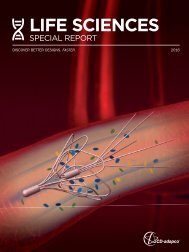Life Science Special Report December 2015
The Life Sciences Sector is experiencing an unprecedented change...
The Life Sciences Sector is experiencing an unprecedented change...
- No tags were found...
You also want an ePaper? Increase the reach of your titles
YUMPU automatically turns print PDFs into web optimized ePapers that Google loves.
DENTAL CEMENT PROJECT LIFE SCIENCES<br />
cement has also been evaluated. Figure 11<br />
shows the IVA system with cement loaded<br />
in a toroid shape containing 30mm 3 ,<br />
35mm 3 and 45mm 3 of cement. These<br />
results indicate that loading the crown with<br />
too much cement causes cement to be<br />
forced out at the crown-abutment margin,<br />
yet resulting in an incomplete fill of a screw<br />
access hole when internal venting is used.<br />
Similar results were obtained for the CA<br />
and the OA system.<br />
FIGURE 5: 3-D images generated in STAR-CCM+® showing the details of cement<br />
fl ow during crown seating on the CA<br />
CONCLUSION<br />
STAR-CCM+® was used to analyze the<br />
complex fl ow fi elds associated with<br />
cementation of implant restorations,<br />
opening the door for virtually addressing<br />
the health problems associated with<br />
extrusion of cement into the soft tissue<br />
surrounding the implant. Great insight was<br />
gained into the cement fl ow patterns for<br />
various cement application techniques<br />
and abutment modifi cations. Simulations<br />
with STAR-CCM+® predicted the patterns<br />
observed in recent experimental test<br />
making it well-poised for future studies.<br />
This is destined to result in a paradigm<br />
shift in the dental fi eld.<br />
FIGURE 6: Geometries for each type of abutment: CA, OA, IVA<br />
extruded from the system is significantly<br />
larger with the CA system as compared to<br />
the OA or IVA system. The IVA is observed<br />
to be the best performer, with almost<br />
no cement entering into the surrounding<br />
environment. The simulations also support<br />
the observation that there is a better infill<br />
of the screw access channel with the IVA<br />
system compared to the OA system.<br />
Cement Application Site<br />
STAR-CCM+® was used to evaluate how<br />
cement application site affects cement<br />
fl ow patterns. Figure 8 displays the results<br />
of two simulations where the same amount<br />
of cement (~35 mm 3 ) was loaded in a ½<br />
toroid shape near the margin of the crown<br />
in the fi rst case and in the occlusal half of<br />
the crown in the second case. Five cross<br />
sectional frames are shown as the crown<br />
is seated on the CA. Results indicate that<br />
when cement is applied high up in the<br />
crown, the occlusal space fills up much<br />
faster as compared to the case where<br />
it is loaded at the crown margin. Once<br />
the occlusal space is completely filled,<br />
pressure on the cement below it increases<br />
signifi cantly. As a result, the extrusion of<br />
cement happens much earlier when loaded<br />
in the occlusal half of the crown; it leaves<br />
the system even before the crown fully<br />
seats. In the fi nal position, this causes<br />
an incomplete margin seal, a greater<br />
extrusion site and an increased mixing of<br />
air and cement as it exits the system.<br />
Speed of Crown Seating<br />
Simulations were performed with three<br />
different speeds of crown seating to<br />
assess the effect of speed on cement fl ow<br />
patterns for each abutment modifi cation.<br />
Figure 9 shows the fi nal position for the<br />
CA, when the crown is seated in 0.25 sec<br />
versus 1 sec. It shows visually that the<br />
crown should not be seated too rapidly if<br />
the seal is to be maintained. Figure 10<br />
shows the results for the IVA system.<br />
In this case, a higher seating speed is<br />
benefi cial, as it enables fi lling up the<br />
screw access hole completely, before<br />
cement is extruded in the surrounding<br />
environment. A similar behavior for the OA<br />
system was observed.<br />
Amount of Cement in the System<br />
The effect of overloading the crown with<br />
THE TEAM<br />
Dr Wadhwani is a specialist dentist<br />
(Prosthodontist) conducting research<br />
on implant restorations. He is a<br />
fellow of the ITI (International Team<br />
Implantology) and lectures nationally<br />
and internationally on dental<br />
implants. He has received awards<br />
for his research work which he<br />
conducts with several dental schools<br />
including: University of Washington,<br />
University of Texas and University of<br />
California San Francisco.<br />
Dr Chung graduated from the<br />
National Defense Medical<br />
Center, TAIWAN with a DDS<br />
degree. He received his PhD<br />
degree in Biomaterials from the<br />
Northwestern University in Chicago<br />
and a certifi cate in Advanced<br />
Prosthodontics from the University<br />
of Texas, Health <strong>Science</strong> Center<br />
in San Antonio. He was appointed<br />
by the University of Washington<br />
as a full Professor of Restorative<br />
Dentistry Department in 2006. Dr<br />
Chung is a Fellow of Academy of<br />
Dental Materials and published<br />
more than 95 articles in peerreviewed<br />
journals and has lectured<br />
both nationally and internationally.<br />
SPECIAL REPORT<br />
29



